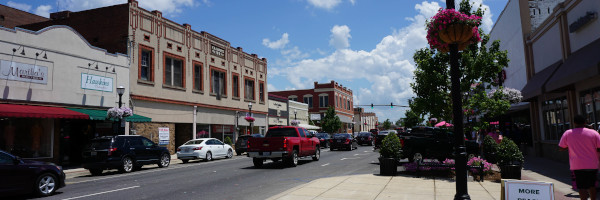Empowering Ruston City Services Using Wireless Sensor Networks
| Empowering Ruston City Services Using Wireless Sensor Networks | |
|---|---|

| |
 City of Ruston | |
| Team Organizations | Louisiana Tech University City of Ruston |
| Team Leaders | Benjamin Drozdenko Elizabeth Matthews Prashanna Bhattarai |
| Participating Municipalities | Ruston Louisiana |
| Status | Ready for Public Announcement |
| Document | None |
Description
The City of Ruston, Louisiana has a number of ongoing projects to improve the quality of life for its residents, including a Smart Grid system and a downtown fiber optic network. Louisiana Tech University plans to develop low-cost improvements to city services using the fiber-topic and small cell installations to enable smart transportation, smart weather, and smart flood risk monitoring and notification capabilities that can be viewed via a Smartphone App. We also plan to study the use of smart re-closers, wireless connectivity, and solar power potential.
Challenges
The issues that the City of Ruston faces include managing the power distribution to all residents and businesses, handling downtown parking and congestion, dealing with natural disasters including floods and tornados, and finding ways of reducing energy consumption.
Solutions
We propose a Smarty City collaboration with Louisiana Tech University for exploring expansion of the Smart Grid system to collect other sensor data, esp. regarding weather and transit conditions. We plan to make relevant statistics available to Public Works via an online dashboard.
Major Requirements
- Develop upon Ruston’s existing power grid system
We will explore self-healing capabilities by analyzing the history of faults and related statistics and incorporating automatic reclosers into the current system. For solar plant and EV charging stations, we will explore potential issues due to voltage unbalance on 3 phases and voltage distortion due to power converters.
- Improve the City of Ruston’s Transportation and Connectivity
We plan to expand upon the city’s existing fiber-optic connections and future small cell installations, and use it for collecting and transferring other environmental sensor data. We plan to analyze the city’s current downtown parking system and incorporate sensors for detection of cars exceeding 3-hour limits, improve ticket detection, and monitor overall parking patterns to improve availability downtown.
- Design Capabilities for Smart Weather Monitoring and Notification
We plan to establish a mesh grid topology wireless sensor network to monitor important atmospheric conditions, including wind direction & speed, temperature, humidity, pressure, and rainfall for a local region in real time. We will alert emergency management officials to more precise locations of potentially damaging weather events such as severe storms, hurricanes, and flash flooding, and make relevant data available to the public via a Smartphone App.
- Prototype Tools for Smart Flood Risk Monitoring
We will also monitor rainfall rates and watershed runoff to the north, east, and south. By identifying ponding of runoff and constricted flows, we will identify existing and potential flood risk areas and mitigate future flood damage. We will also monitor the effect of new construction and booming development on storm water runoff over time to halt flood risk increases.
- Explore Smart Solar Power Potential
The sensor network will also monitor solar radiation to evaluate the potential for expanding the adoption of solar power for electric vehicle recharging stations and other uses.
Performance Targets
| Key Performance Indicators (KPIs) | Measurement Methods |
|---|---|
|
|
Standards, Replicability, Scalability, and Sustainability
The project can ensure replicability, scalability, and sustainability of operations. The principal participants at Louisiana Tech University plan to record and publish the procedures that we undertake to establish this Smart City infrastructure, and record the discussion of meetings with city officials to keep track of important negotiations. These records will establish replicability, which in addition to any publications and demonstration at the GCTC expo, will ensure that other university researchers can follow our steps to form teams with public officials and install similar sensing equipment. The project will demonstrate scalability by demonstrating how such a network can expand over time, by adding additional sensors to acquire a finer-grained information about weather and transit conditions. The project will be sustainable because it will formalize a consistent upkeep and maintenance schedule by both university faculty and public employees. Any equipment initially prototyped and installed by faculty participants will be transferred to the city once a formal upkeep procedure has been set in place.
Cybersecurity and Privacy
The proposed solution was designed to address user uncertainties and risks of both cybersecurity and privacy. The proposed project is intended to address the question of whether the Smart Grid data is secure and private. We plan to first identify what security measures are presently being undertaken to encrypt or restrict access to this data. For this, we plan to study in depth the embedded systems used for data collection and their operating systems, the available wireless protocols and cloud infrastructure for security flaws. Smart meter data will be classified as public or private information to determine whether it could be shared and used for purposes such as load balancing or whether it must be protected from unauthorized parties. Our approach will make it more difficult for malicious users to perform interference using techniques such as adding artificial noise and lightweight cryptography solutions.
Impacts
The improvements to the smart grid system, including the incorporation of smart reclosers, and exploration of solar power potential should have positive impacts on energy usage throughout the city. The placement of Smart City sensors for weather and flood monitoring will improve the environmental conditions in the area by enabling public works to react to them more quickly, and improve safety by notifying residents via the Smartphone App of the more precise locations of natural disasters. The Smart Transportation and Connectivity objectives will improve the quality of life by decreasing parking wait time and reducing congestion. The reduced traffic congestion may also potentially improve the pedestrian safety of the downtown area.
Demonstration/Deployment
A project pilot demonstration will take place in the Spring 2019 GCTC Expo. At this pilot, we will reveal our Smart City dashboard prototype, and display small amounts of data points that have been collected from the sensor network and uploaded to the cloud. At the Winter 2019 and future GCTC expositions, we will demonstrate scalability by introducing more sensors at each 6-month period, increasing on a linear scale. We will also reveal links to our notes and procedures for our project so that other researchers at the Expo can replicate our work.